Big data and API for SEO and online marketing
Enterprise-level API and custom data sets delivered on-demand for any Google SEO task including:




Real-time APIs
On-demand APIs and data sources
Business case 1
The US car rental business wants to track competitive landscape changes by estimating a search traffic share which might be used as a proxy metric for total market share.
Data collection pipeline
Prerequisites
To calculate traffic share SERP click-through rate (CTR) distribution by position is needed. Get this data from available sources or estimate it using Google Search Console data.

Car rental can be used here as a topic that includes a huge number of keywords related to that topic. Get the initial keywords list by calling the Keywords selection API method. Then loop through this list and expand it using Search suggestions and Related Keywords API methods applied to each keyword.
To collect even more keywords apply all three methods to the resulting list several times. Use filtering and sorting options to clean up the keywords list. For instance, filter keywords by search volume to get only the most popular keywords.

For each keyword in the final keywords list get the US SERP using SERP crawling API methods. Store all the SERPs data in a local database with the keywords data and a date of crawling.


Calculate search traffic for each keyword and each SERP position by multiplying keyword volume by CTR. Aggregate the results by domain to get the domain traffic as a sum of keyword-position traffic. Calculate domain traffic share as a percentage of domain traffic related to the traffic sum of all the domains.
A plot of the results might look like this:

Run stages 1 to 3 on a schedule to understand the changes in the competitive landscape over time. The frequency of updates is up to the business. Daily updates might be a good choice to balance the number of insights and pipeline costs.
Business case 2
US-based marketing agency expands its PPC market presence. They need a source of new prospects.

Agency gets a custom dataset with the US domains that are above the discussed threshold measured as a number of paid keywords and ads per domain. The dataset contains data on domain search traffic, domain visibility, number of referring domains and backlinks, and number of paid keywords and ads.
The data is uploaded monthly to cloud storage in CSV format. On top of this uploaded data, the marketing agency builds a prospect scoring system that helps the SDR team to find the most valuable prospects.
Business case 3
The global financial institution wants to assess risks and find opportunities in asset management in multiple regions.
Data pipeline

For each region collect a list of keywords related to the area of expertise using Keyword selection and Related keywords API methods. Use this list as a proxy for in-region demand estimation. Get the SERPs for each keyword using the Top by keyword API method or SERP crawling API. Extract all the domains from all SERPs.

For each region loop through the list of domains to get the data on search and backlinks metrics using Domain summary and Backlink summary API methods. Store the data in local storage and enrich it with the data from other data sources. Build a machine learning scoring model to get the relative strength of each domain.

For each region get a list of top pages for each domain using the Top pages API method and the keywords for all these pages using the URL keywords API method. Use this as a proxy for supply estimation. Compare demand and supply to see the growth of new topics and companies in these topics.

Estimate the marketing budget based on keywords CPC and search volume, number and quality of backlinks, and the amount of new content created. Build a market research report and get a list of investment opportunities based on domain score, demand, and marketing budget.

Assess the country-related risks based on domain metrics distribution and dynamics. Reallocate assets from risky regions.
Business case 4
A newcomer in the highly competitive European market wants to build a complex search domination strategy to increase the market share.
Data pipeline

Collect low-volume keywords using keyword research API methods and create content to get the initial results from SEO efforts. With SERP crawling API collect SERPs to track the changes in a competitive landscape, news, sales, own indexing issues, and keywords cannibalization. Look for competitors' PPC daily bidding adjustments and PPC campaign expansion.
Collect low to no-competition keywords using the same methods and test PPC campaigns to find the blind spots in competitors' strategies. Use Tree view for initial keyword grouping and landing page analysis.

Balance SEO and PPC on a per keyword level. Both should support each other and add some incremental results but not just cannibalize the existing ones. Use SERPs data to adjust PPC bids according to SEO results.

Run an SEO audit using Site audit API methods after each major website update or SEO-related fix to quickly react to issues that might affect website search presence. Also, run an audit on a staging server that is password protected from external traffic. Check if something is broken before the changes go live.
Audit competitors' websites to see when they have some issues and use that as a trigger in competitors-targeted PPC campaigns.

After getting a strong presence in low-volume keywords move to mid-volume and high-volume by scaling already established processes.
Business case 5
European company wants to perform keyword research in a narrow niche to boost SEO results.
Data pipeline

Create a list of common words that describe the niche and get a list of search competitors for these words using Competitors API methods. Collect keywords for each competitor using the Domain keywords API method. Use Domain vs domain API method to find out what keywords are common for all competitors and what are distinct.

Collect the last 12-month keyword volume history for all keywords with Search volume crawling API to see the demand seasonality. Track rankings for all keywords with SERP crawling API to control the SEO progress and see the changes in the competitive landscape. Repeat the whole procedure regularly to see how competitors expand their business outside the niche.
Business case 6
US-based marketing agency wants to automate backlinks discovery strategy for dozens of clients
Data pipeline

Collect a competitors list for each client with Competitors API methods for keywords and domains. For each competitor get a list of referring domains with Referring domains API method.

Check if competitors are using link networks by looping through the referring domains several levels deep. Find the intersection of all the lists with the Link intersection summary API method to get a filtered list of possible link sources. Reach out to these sources to get backlinks to your website.

Use the Malicious domains API method to disavow all the links from malicious domains.
Business case 7
UK B2B SaaS company wants to get more leads
Data pipeline

With Keywords research API methods collect the initial list of keywords that describe leads' niche. Get a list of websites that compete in the search for these keywords.

For each website use the Top pages API method to see if the company provides the services related to B2B SaaS. Check if some companies might be considered sales or marketing partners. Check the SERPs for company-related review search queries with SERPS crawling API methods to reduce the reputation risks related to potential partners. Offer SaaS to the selected companies.